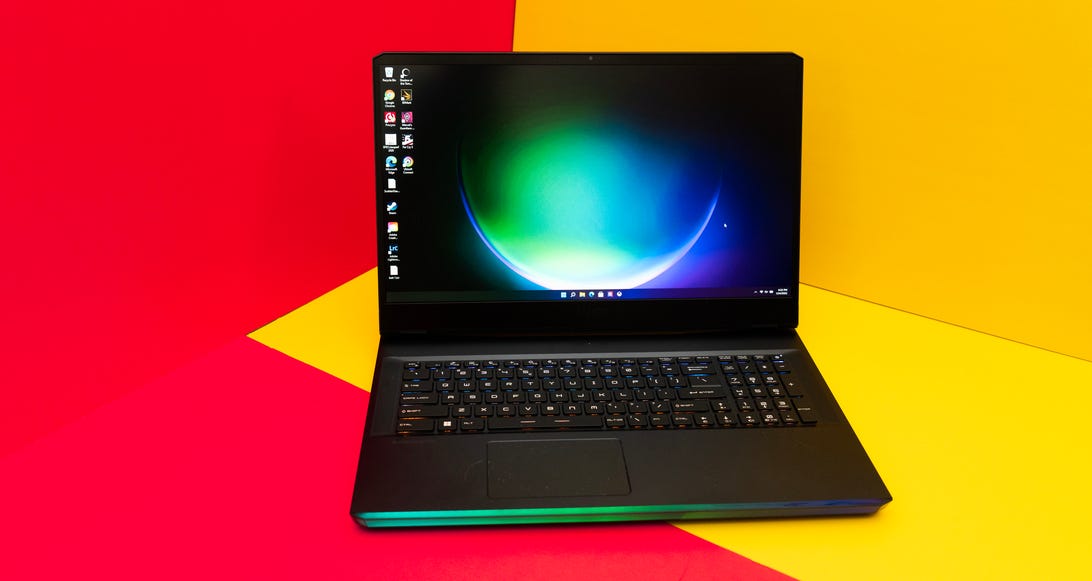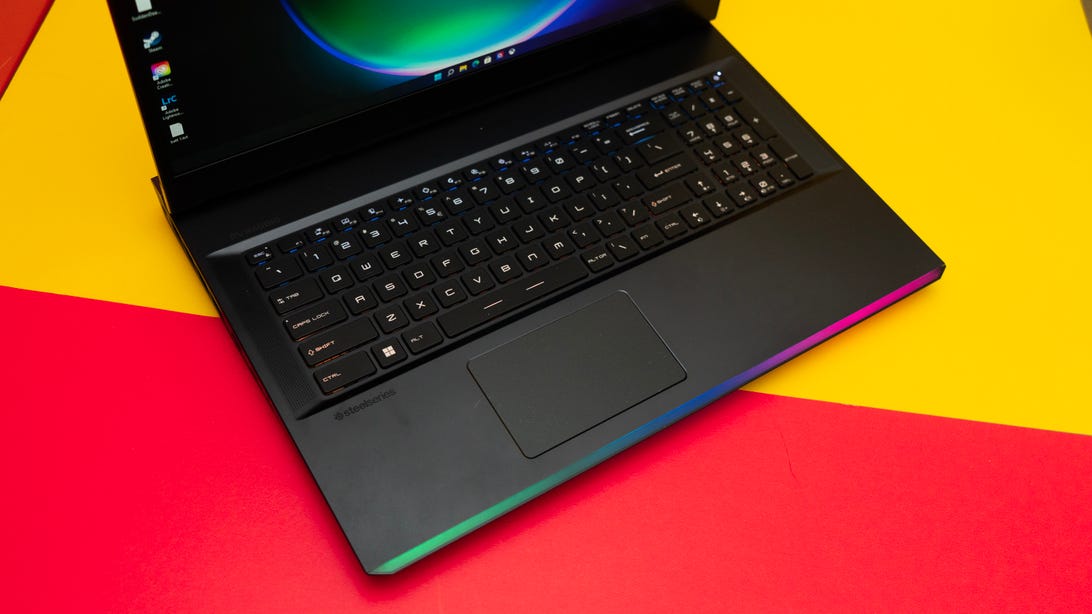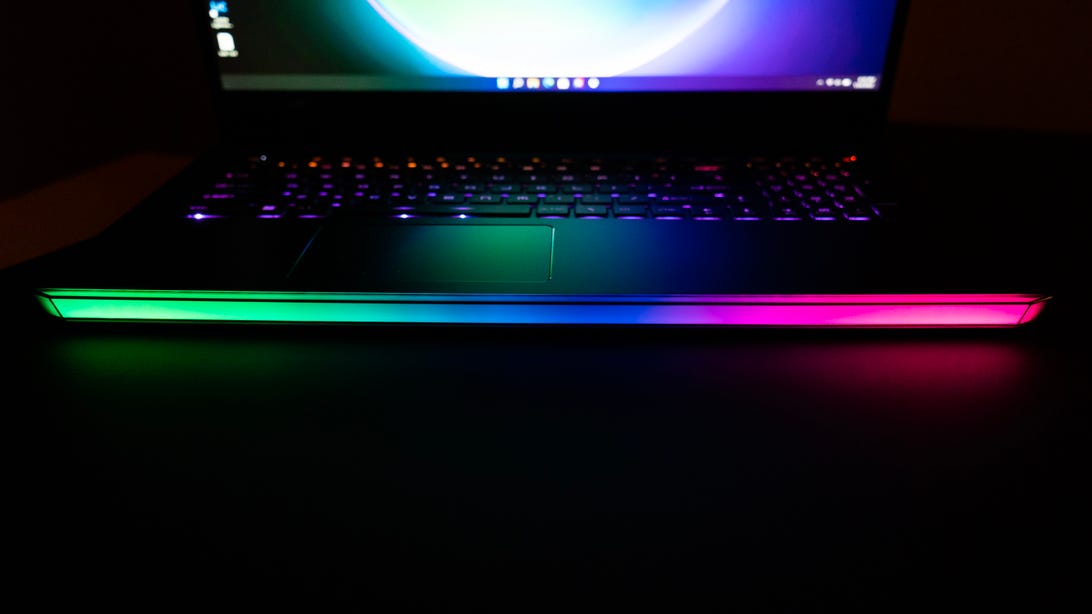
Lori Grunin/CNET
MSI’s top-end 17-inch Raider GE76 gaming laptop comes with state-of-the-art components that let it fly. It’s stacked with an Intel Core i9-12900HK CPU and Nvidia GeForce RTX 3080 Ti GPU. That processor is the newest Intel mobile Alder Lake architecture, which splits the cores into performance-optimized and efficiency-optimized (like Apple’s M1 chips). And while the RTX 3080 Ti is just a new iteration of Nvidia’s top mobile GPU, the MSI shows how well it performs when you push it — and not even to the max — in a system that allows it to draw full power.
In other words, the components are performing better than they would on a laptop with a pretty thin-and-light design; those have to compromise on power for the sake of cooling, battery size and AC adapter size. The downside is that the Raider is a lot more traditional. It also lacks Nvidia’s Advanced Optimus, which is better at juggling the internal and discrete GPUs than the older version of Optimus used in the Raider GE76.
Like
- Fast
- Has a full array of connectors
- Decent battery life for a 17-inch gaming laptop
Don’t Like
- Expensive
- Loud fans
- Doesn’t incorporate Nvidia’s Advanced Optimus
- Relatively small touchpad
- Not crazy about the keyboard feel
The Raider GE76 comes in about seven different configurations that range in price from $1,599 (with an i7-12700H, RTX 3060 and 1080p 360Hz display) to $4,199 (i9-12900HK, RTX 3080 Ti and 4K 120Hz display). Our test system configuration isn’t available here, but the closest option, with an i9-12900HK, RTX 3080 Ti and 1440p 240Hz display for $3,999 is actually better; 4K can be overkill for 17 inches and 1080p is OK, but QHD is just right. (Since exchange-rate conversions bear no relation to the regional pricing, I haven’t included them.)
It’s pretty pricey overall, and currently still in preorder, since it’s not shipping until around late March. It’s definitely worth waiting to see what’s out there around the same time.
MSI Raider GE76
| MSI Raider GE76 | |
|---|---|
| Price as reviewed | N/A (closest configuration is $3,999) |
| Display | 17.3-inch 360Hz 1080p |
| PC CPU | Intel Core i9-12900HK |
| PC Memory | 32GB DDR5-4800 |
| Graphics | Nvidia GeForce RTX 3080 Ti |
| Storage | 2TB NVMe SSD (with DirectStorage support), SD card reader |
| Ports | 4 x USB-A, 1 x USB-C/Thunderbolt, 1 combo audio, 1 x HDMI 2.1, 1 x Mini DisplayPort 1.4 |
| Networking | Killer Wi-Fi 6E AX1675, 2.5Gb Killer E3100 |
| Operating system | Microsoft Windows 11 Pro (21H2) |
| Weight | 6.4 pounds (2.9 kilograms) |
The laptop’s screen isn’t on the GPU bus, so the battery life is highly dependent on whether you remember to switch into hybrid mode. (In hybrid mode, the rendering and acceleration are performed by the Nvidia GPU and passed over the system bus to the CPU to render to the screen, which might make it a bit slower.) That means you have to manually force it to use the discrete graphics — it can’t toggle back and forth intelligently and automatically, and you have to reboot to switch. MSI does have a utility that automatically switches in and out of “extreme” mode as you launch games.
My performance test results place it as best in class — or close — across the board, and by a significant margin in some cases. Single-core speed, traditionally Intel’s strong point, is also impressive. When you combine all the advances in GPU and CPU in the system, it becomes a powerhouse for video editing (though if you really want to you probably want a better screen than the run-of-the-mill model I tested, which is optimized for refresh rate).
You can overclock the GPU and VRAM up to 200MHz each via MSI’s utility. Simply bumping the GPU up by 100MHz lifted performance on Rift Breaker’s GPU test and FireStrike Ultra by about 6%, and Port Royal (which measures Nvidia’s RTX ray-tracing performance) by about 7%. That’s quite good and means there’s room for more uplift, as long as you’re willing to put up with the fan noise.

The touchpad feels a little small relative to the size of the laptop.
Lori Grunin/CNET
This isn’t really a “laptop” laptop. It’s a desktop replacement, so I’m not sure how important a little extra battery life is. Still, when you let the system use its intelligent power handling (without forcing it into save-battery-at-all-costs mode) it lasted about 5 to 6 hours streaming video continuously over Wi-Fi, which is unusually long for a traditional 17-inch gaming system. It’s big and relatively heavy, with one of those mondo power bricks that add another two pounds to the carry weight. It can also get pretty loud, even in hybrid mode, though it doesn’t seem to run particularly hot.
While it performs exceptionally well on all counts, that’s due to all the new components in it, and this is the first time we’ve tested them. I do expect to see a lot of systems that perform comparably as 2022 wears on.
Among the laptop’s performance-related perks is support for DirectStorage, Microsoft’s programming interface for high-bandwidth SSD file operations in Windows (and the Xbox Series X/S), that, combined with its Samsung SSD and PCIe 4 bus, delivers quite a nice score of 2,802 on 3DMark’s SSD performance test (we’re still building our database of comparison numbers).
A lot of swings, some misses
MSI’s also one of the first companies to partner with BlueStacks for its mobile-gaming-on-laptop technology. Incorporated into its MSI App Player, it theoretically lets you play Android games on the laptop as if they were written for a PC — a bigger screen, high-power processing, full controller support and more.

Lori Grunin/CNET
But it’s really hit and miss, at least on the MSI. For instance, Dead Cells, which is listed on BlueStacks’ site as a compatible game, wouldn’t run. Little Adventures did, but when I rotated it to landscape to take advantage of the bigger screen, it literally just rotated the game, leaving it lying on its side. The App Player is simply emulating a phone — if the game doesn’t support landscape or a controller, it won’t. And it doesn’t tell you that; you just have to discover by trial and error. The Home screen for the player shows BlueStacks-optimized games, but at least a casual look-through didn’t turn up a single A-lister.
Given the size of the laptop, the touchpad is too small, and I’m finding it intermittently nonresponsive. Plus, the SteelSeries keyboard feels mushy; quiet, but more like gel than membrane. I do like the laptop’s lighting design, but I’m a sucker for a lightbar (as well as underglow).
And MSI touts the full HD (1080p) webcam, but there’s a lot more to a good webcam than resolution. Most of the best have a lot of supporting intelligence to deliver decent autoexposure and white balance at the very least, but this one’s pretty meh, even in controlled lighting. It should be fine for basic videoconferencing, but you may want to buy a better external one if you care about image and especially if you plan to stream.
If you’re in the market for a speedy upgrade over whatever you’re gaming on now, the MSI Raider GE76 definitely delivers — as long as you’re willing to plonk down a lot of money before seeing what the rest of the competition does with similar components, or what arrives a little later this year in a thinner-and-lighter package (between March and June) than the Raider line.
Performance snapshot
Geekbench 5 (multicore)
Asus ROG Flow X13 with XG Mobile
Asus ROG Strix Scar 15 (G533QS)
Note:
Longer bars indicate better performance
Cinebench R23 CPU (single core)
Asus ROG Flow X13 with XG Mobile
Asus ROG Strix G15 Advantage Edition (G513QY)
Note:
Longer bars indicate better performance
Far Cry 5 (1080p)
Asus ROG Strix G15 Advantage Edition (G513QY)
Asus ROG Flow X13 with XG Mobile
Note:
Longer bars indicate better performance (FPS)
Shadow of the Tomb Raider gaming test (1080p)
Asus ROG Strix G15 Advantage Edition (G513QY)
Asus ROG Flow X13 with XG Mobile
Note:
Longer bars indicate better performance (FPS)
3DMark Time Spy
Asus ROG Strix G15 Advantage Edition (G513QY)
Asus ROG Flow X13 with XG Mobile
Note:
NOTE: Longer bars indicate better performance
3DMark Fire Strike Ultra
Asus ROG Flow X13 with XG Mobile
Asus ROG Strix G15 Advantage Edition (G513QY)
Note:
Longer bars indicate better performance
3DMark Port Royal
Note:
Longer bars indicate better performance
Procyon Video (Premiere Pro)
Asus ROG Strix G15 Advantage Edition (G513QY)
Asus ROG Flow X13 with XG Mobile
Note:
Higher scores indicate better performance
SpecViewPerf 2020 SolidWorks (1080p)
Asus ROG Flow X13 w/ XG Mobile
Note:
Longer bars indicate better performance (FPS)
Configurations
| Alienware m17 r4 | Microsoft Windows 10 Home (20H2); 2.4GHz Intel Core i7-10980HK; 32GB DDR4 SDRAM 2,933MHz; 16GB Nvidia GeForce RTX 3080 512GB SSD + 953GB RAID 0 |
|---|---|
| Asus ROG Flow X13 with XG Mobile | Microsoft Windows 10 Home (2004); 3.3GHz AMD Ryzen 9 5900HS; 6GB DDR4 SDRAM 4,266MHz; 4GB Nvidia GeForce GTX 1650 (16GB GeForce RTX 3080 mobile in XG Mobile) |
| Asus ROG Strix G15 AMD Advantage Edition | Microsoft Windows 10 Home (21H1); 3.3GHz AMD Ryzen 9 5900HX; 16GB DDR4 SDRAM 3,200MHz; 12GB AMD Radeon RX 6800M; 512TB SSD |
| MSI Raider GE76 | Microsoft Windows 11 Pro (21H2); 2.9GHz Intel Core i9-12900HK; 32GB DDR5 SDRAM 4,800MHz; 16GB Nvidia GeForce RTX 3080 Ti; 2 x 1TB NVMe SSD |









